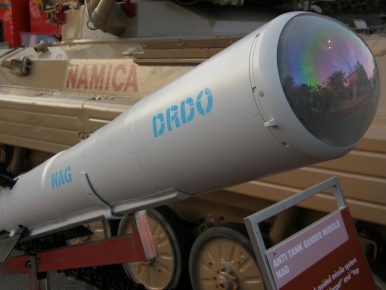By Franz-Stefan Gady
 The third-generation anti-tank guided missile (ATGM) Nag is slated to enter production by the end of 2019, according to a senior Indian defense industry official.
The third-generation anti-tank guided missile (ATGM) Nag is slated to enter production by the end of 2019, according to a senior Indian defense industry official.Speaking to IHS Jane’s at the Aero India 2019, a biennial air show and aviation exhibition held in Bengaluru, India at the Yelahanka Air Force Station, MSR Prasad, director general of Missiles and Strategic Systems (MSS) at India’s Defense Research and Development Organization (DRDO), told the trade publication that the Nag ATGM will undergo final user trials in May and June this year with production of the weapon system expected to kick off later in 2019.
Winter user trials of the Nag ATGM were successfully completed in December 2018. This was preceded by extensive validation trials of the a fire-and-forget ATGM’s imaging infrared (IIR) seeker head, which caused repeated delays due to the technical inadequacies of the thermal sensors. In February 2018, DRDO successfully tested the Nag against in desert conditions against two tank targets.
After the February 2018 tests, the Indian Ministry of Defense announced that the ATGM system was now ready for induction into service with the Indian Army. (The service claims that it lacks 68,000 ATGMs of various types and around 850 launchers.) The Indian Army is expected to purchase 8,000 Nags with an initial order of 500 NAGs. The ATGM system will be manufactured by India’s sole missile producer, state-owned Bharat Dynamics Limited.
DRDO has been working on the Nag ATGM for over a decade. All ground tests to date have been conducted from a specifically designed armored combat vehicle. As I reported in 2017:
The Nag Missile Carrier (NAMICA) is an Indian license-produced variant of the Soviet-era BMP-II armored infantry fighting vehicle. NAMICA can launch Nag missiles from a retractable armored launcher that contains four launch tubes (the armored vehicle can carry up to 12 missiles in total) and the guidance package including a thermal imager for target acquisition. The missile’s targeting system is based on visual identification prior to its launch (‘lock-on-before-launch system’).
To date, no contract has been signed between the Bharat Dynamics Limited and the Indian MoD. It is unclear whether the Indian Army’s chief concern including various technical shortcomings and the high price of the weapon system have been addressed.
DRDO has reportedly also been working on a man-portable version of the Nag. DRDO has also been working on a more advanced air-launched variant of the Nag, the Helina ATGM. The Helina ATGM was successfully test fired earlier this month. The government scrapped a $500 million deal with Israeli defense contractor Rafael Advanced Defense Systems Ltd. for 321 Spike ATGM systems and 8,356 missiles in favor of an indigenously designed and developed man portable anti-tank guided missile (MPATGM). The MPATGM was last test fired in September 2018.
Last month, the Indian MoD approved the procurement of 5,000 French-made second-generation MILAN ATGMs. The total value of the defense deal is estimated at over $167 million.
